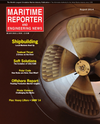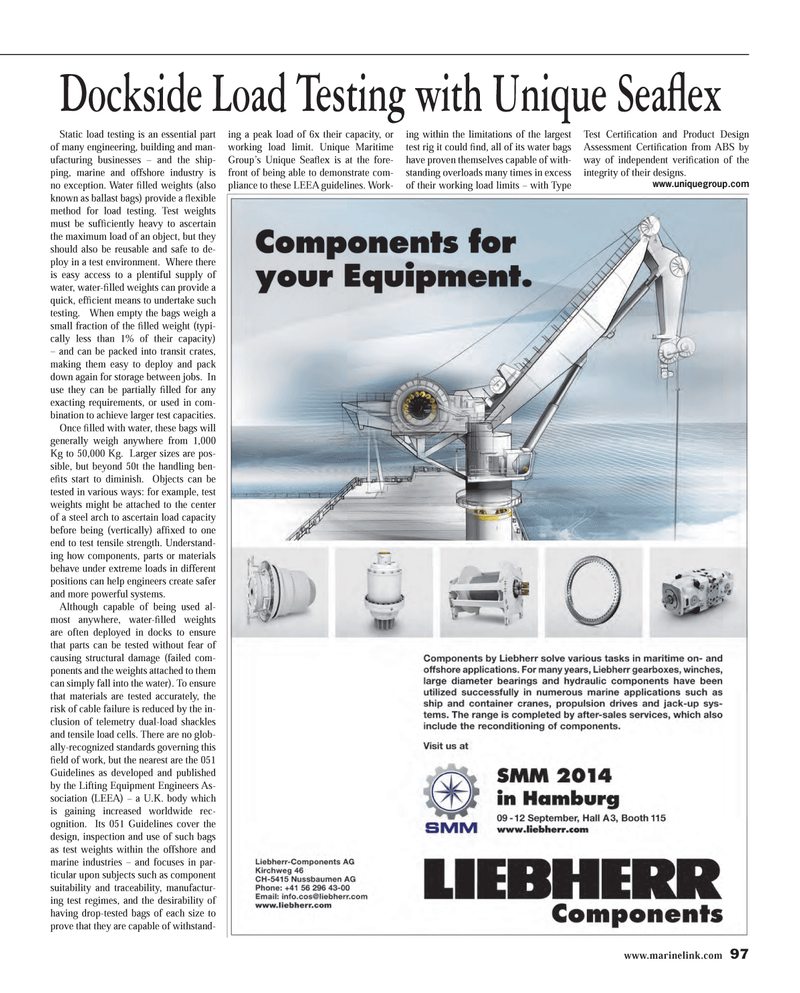
Page 97: of Maritime Reporter Magazine (August 2014)
Shipyard Edition
Read this page in Pdf, Flash or Html5 edition of August 2014 Maritime Reporter Magazine
www.marinelink.com 97Static load testing is an essential part of many engineering, building and man-ufacturing businesses ? and the ship-ping, marine and offshore industry is no exception. Water Þ lled weights (also known as ballast bags) provide a ß exible method for load testing. Test weights must be sufÞ ciently heavy to ascertain the maximum load of an object, but they should also be reusable and safe to de-ploy in a test environment. Where there is easy access to a plentiful supply of water, water- Þ lled weights can provide a quick, efÞ cient means to undertake such testing. When empty the bags weigh a small fraction of the Þ lled weight (typi- cally less than 1% of their capacity) ? and can be packed into transit crates, making them easy to deploy and pack down again for storage between jobs. In use they can be partially Þ lled for any exacting requirements, or used in com-bination to achieve larger test capacities. Once Þ lled with water, these bags will generally weigh anywhere from 1,000 Kg to 50,000 Kg. Larger sizes are pos- sible, but beyond 50t the handling ben-eÞ ts start to diminish. Objects can be tested in various ways: for example, test weights might be attached to the center of a steel arch to ascertain load capacity before being (vertically) afÞ xed to one end to test tensile strength. Understand-ing how components, parts or materials behave under extreme loads in different positions can help engineers create safer and more powerful systems.Although capable of being used al-most anywhere, water- Þ lled weights are often deployed in docks to ensure that parts can be tested without fear of causing structural damage (failed com-ponents and the weights attached to them can simply fall into the water). To ensure that materials are tested accurately, the risk of cable failure is reduced by the in-clusion of telemetry dual-load shackles and tensile load cells. There are no glob- ally-recognized standards governing this Þ eld of work, but the nearest are the 051 Guidelines as developed and published by the Lifting Equipment Engineers As- sociation (LEEA) ? a U.K. body which is gaining increased worldwide rec-ognition. Its 051 Guidelines cover the design, inspection and use of such bags as test weights within the offshore and marine industries ? and focuses in par- ticular upon subjects such as component suitability and traceability, manufactur- ing test regimes, and the desirability of having drop-tested bags of each size to prove that they are capable of withstand-ing a peak load of 6x their capacity, or working load limit. Unique Maritime Group?s Unique Sea ß ex is at the fore- front of being able to demonstrate com-pliance to these LEEA guidelines. Work- ing within the limitations of the largest test rig it could Þ nd, all of its water bags have proven themselves capable of with-standing overloads many times in excess of their working load limits ? with Type Test Certi Þ cation and Product Design Assessment CertiÞ cation from ABS by way of independent veriÞ cation of the integrity of their designs. www.uniquegroup.com Dockside Load Testing with Unique Seaß exMR #8 (90-97).indd 97MR #8 (90-97).indd 978/7/2014 10:04:47 AM8/7/2014 10:04:47 AM

 96
96

 98
98
